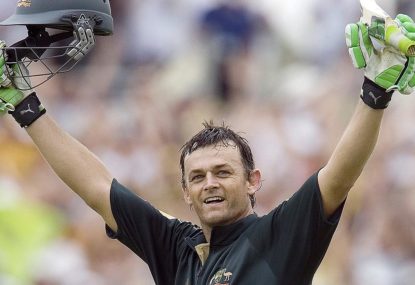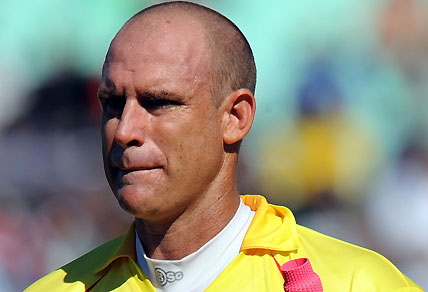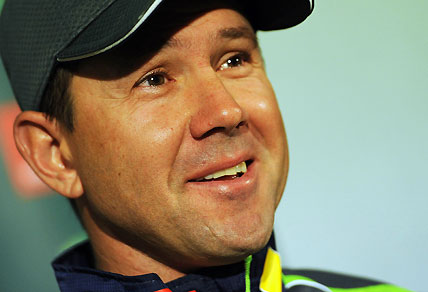Travis Head obliterates RCB in record breaking century... and just wait for the celebration!
RCB have suffered a massive HEAD-ACHE after Travis Head smashed the fastest century by an SRH player in just 39 balls, as they amassed…

It has been ten years since the ninth edition of the Cricket World Cup, which began in the Caribbean on 13th March, 2007 and featured a record 16 teams.
The tournament drew considerable flak from many quarters for its long-drawn format and overpriced tickets, not to mention the embarrassing gaffe by the umpires in the rain-reduced final between Australia and Sri Lanka.
According to the critics, the shocking death of Pakistan’s coach Bob Woolmer and the early ousters of marquee teams such as India and Pakistan further dampened the tournament that was trumpeted to be the world’s biggest cricket carnival.
However, the showpiece event saw plenty of eye-catching performances and fairytale moments that are still fresh in the memory even after a decade. For instance, Ireland’s remarkable giant-killing journey is now part of cricketing folklore, while Australia blitzed to their third successive title with a ruthless domination over every team they faced.
Let us look back at the best from the saga that was the 2007 World Cup.
A rush of records
A clutch of new World Cup records were created in the 2007 edition. India became the first team to surpass the 400-run barrier, scoring 413/5 against Bermuda; their 257-run win becoming the biggest victory margin.
A record aggregate of 671 was gathered as well, in the group match between Australia and South Africa at Basseterre; in the same match, Matthew Hayden scored the fastest World Cup hundred, off 66 balls. All these records have since been broken.

Australia conquer one and all
Never before had any team imposed their supremacy in a World Cup tournament in the manner Australia did in 2007. Gunning for a hat trick of titles, Ricky Ponting’s men won all eleven matches in thumping fashion to reaffirm their status as the undisputed kings of ODI cricket.
They reserved their most clinical display for New Zealand – the team that had whitewashed them 3-0 in the Chappell-Hadlee Trophy in the lead-up to the tournament. The Black Caps were thrashed by a whopping 215 runs at St George’s in the Super Eight stage as Australia provided a rude reminder that no one could hold a candle to them on the biggest stage of them all.
Their inevitable march towards glory culminated with handsome wins over South Africa – who crashed to 27/5 after batting first – and Sri Lanka in the semi-final and final respectively.

Pluck of the Irish
First-time participants Ireland, clubbed in a tough Group D, were the toast of the tournament as they won the hearts of all and sundry with their spunky campaign that produced two memorable wins and a tie against full member teams.
Led by the spirited Trent Johnston, the Irish held Zimbabwe to a nerve-shredding tie at Kingston to show that they were not going to be pushovers as the tournament progressed.
Four days later – on St. Patrick’s Day, no less – at the same venue, Ireland astonished the cricket world by bowling 1992 champions Pakistan out for 132 and then winning by three wickets, thanks to Niall O’Brien’s superb 72. They went on to collect another scalp in the Super Eight round, in the form of Bangladesh, who were resoundingly beaten by 74 runs at Bridgetown.
Tigers come of age
On the same day that Ireland knocked Pakistan out, Bangladesh put India on the brink of elimination with a famous five-wicket win at Port-of-Spain. Disciplined bowling from the Tigers ensured that the fancied Indian batsmen could manage no more than 191.
This win was the ticket they needed to make it to the Super Eight, wherein they upset South Africa by 67 runs. After enduring a winless campaign in 2003, this was a much-needed boost for Bangladeshi cricket.
Pigeon flies off in style
A couple of months before the World Cup, the great Glenn McGrath had a triumphant end to his Test career as Australia regained the Ashes with a 5-0 win at home.
His ODI farewell was even sweeter, as he topped the bowling charts at the World Cup with a record tally of 26 wickets at a stunning average of 13.73, for which he was named Player of the Tournament. His penetrative bowling at the top proved that this Pigeon could fly high even at the age of 37.
Gilchrist squashes Sri Lanka
Australian legend Adam Gilchrist pounded the Sri Lankan attack with a whirlwind 149 from 104 balls in the rain-hit final at Bridgetown. This title-clinching innings – the highest ever in a World Cup final – was studded with 13 fours and eight sixes, and knocked the wind out of the opposition, which was hoping for an encore of the 1996 summit clash when Australia were at the receiving end.
Gilchrist’s assault carried Australia to a winning total of 281/4 in the allotted 38 overs. The secret to his powerful hitting turned out to be a squash ball, which he had placed in the glove of his bottom hand and credited it for giving him a better grip.
It was an unusual tactic to employ, but certainly not illegal. With this win by 53 runs on the D/L method, Australia stretched their unbeaten streak in the World Cup to 30 matches, dating back to 1999.
That catch by Dwayne Leverock
Bermudan policeman Dwayne Leverock, weighing in at over 280 pounds, provided one of the most iconic World Cup moments when he took a catch at first slip off the bowling of 17-year-old Malachi Jones to dismiss India’s Robin Uthappa in a Group B match at Port-of-Spain.
Leverock dived to the right to take a stunning one-handed catch, after which he took off on a celebratory run across the field even as Jones wept with joy. “He has flown like a gazelle…the earth shook! Oh what a catch!”, exclaimed commentator David Lloyd on air.
Though India had the last laugh, smashing 413/5, then the highest World Cup total , en route a 257-run victory, Leverock made sure that he attained cult status with his gravity-defying exhibition of athleticism.
Gibbs goes hammer and tongs
Exciting South African stroke-maker Herschelle Gibbs became the first man to hit six sixes in an over in international cricket, when he achieved the rare feat against the Netherlands in a Group A match at Basseterre. The unfortunate bowler to suffer this onslaught was leg-spinner Daan van Bunge, who returned forgettable figures of 4-0-56-0 as South Africa romped home by 221 runs.
In what was a rain-reduced 40-over affair, the Proteas were warming up nicely at 178/2 when the historic 30th over began. The first one went over long-on, the next two were smote over long-off, the fourth slogged over deep midwicket, the fifth swatted over wide long-off and finally another over deep midwicket. Gibbs scored 72 from just 40 balls as South Africa piled up 353/3.
‘Slinga’ Malinga creates history
Sri Lanka’s curly-haired speedster Lasith Malinga, renowned for his slingshot action, became the first man to capture four wickets in four balls in any form of international cricket during his side’s Super Eight clash with South Africa at Providence.
Needing 210 for victory, South Africa seemed home and dry at 206/5 when Malinga dismissed Shaun Pollock (bowled) Andrew Hall (caught at cover) off the last two balls of the 45th over. He returned in the 47th over and duly removed the well-settled Jacques Kallis (caught behind) for 86 and Makhaya Ntini (bowled) off the first two balls to reduce the score to 207/9.
Nevertheless, South Africa eventually scampered home by one wicket, Malinga’s 4/54 going in vain. His was the fifth instance of World Cup hat-trick, and in 2011, he became the first bowler to take two World Cup hat-tricks.
Swansongs galore
As aforementioned, Glenn McGrath had the perfect send-off from international cricket, but other illustrious names were not as lucky. Pakistan skipper Inzamam-ul-Haq bid a tearful farewell to ODI cricket, bowing out from what was a nightmarish tourney for his team in the last group game against Zimbabwe.
West Indian captain Brian Lara too quit international cricket, after his team failed to meet the expectations of the home crowd. Yet another captain to retire from ODI cricket following the World Cup was England’s Michael Vaughan, while New Zealand’s Stephen Fleming gave up the captaincy after ten years at the helm.
Furthermore, Greg Chappell and Duncan Fletcher, respective coaches of India and England, resigned from their posts. Victorious Australian coach John Buchanan also called time on a highly successful eight-year tenure.